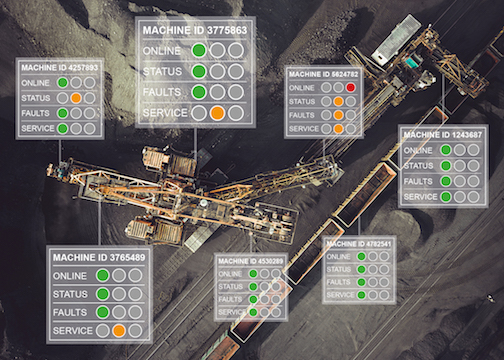Trevor Herbert spoke to the British Aggregates Association (BAA) recently about the opportunities available for practical energy and cost savings using today’s smart automation solutions
Most mines and quarries contain a proliferation of electric motors, powering fans, pumps, conveyors, crushers, winches, hydraulic power packs, etc. They vary in size and importance from large machines that are critical to site safety and operations to smaller examples that enable basic plant processes such as dust suppression and surface water control.
Each one is drawing electricity and unless it is already part of a smart control solution, it could be contributing more towards energy and general cost saving.

The most basic guide is that if a motor has more than fractional kilowatt power rating and has an active duty cycle, then fitting a variable speed inverter drive (VSD) can save money by reducing energy consumption, and will have a reasonable payoff period that makes it worth investing in.
ROI figures typically get better with larger machines and higher duty cycles, however, if you can also take advantage of onboard intelligence such as the built-in PLC functionality featured on Mitsubishi Electric’s FR-A800 series drives, plus compatible Smart Condition Monitoring devices, then the savings start to ramp-up considerably.

Since continuity of production and security of supply tends to dominate commercial concerns due to high operating costs and penalty clauses for delays in supply, these additional features that you can benefit from, alongside the base-line energy saving, can have a huge impact.
We have seen several instances of large pieces of rotating equipment for example that have failed due to the harsh operating conditions which could have been avoided by using a smart condition monitoring device. The total overhead cost of the unplanned downtime completely dwarfs the cost of the solution.
How much money can I save (with Smart Condition Monitoring)?
We are often asked this question in the first instance, swiftly followed by “how much is that going to cost?”.
The answer is invariably, ‘here are some examples, let us survey the plant and provide some actual guideline figures for your facility’.
Generally, the more you invest the more you save, however there is always a point where diminishing returns mean it’s not worth investing any more. So, what is a good rule of thumb?
Since we can provide a VSD solution for almost any size of industrial motor, right up to the higher end of multi-megawatt medium voltage systems, then we tend to start at the top and work down.
The biggest energy savings will usually be on the largest motors, however it’s rare now to find a big 200kW plus unit without an effective VSD installed. This is where the advantage of better plant visibility and live condition monitoring can be crucial.
A Smart Condition Monitoring solution from us is typically a low-cost investment and very quick and easy to install. It helps if there is a Mitsubishi Electric inverter close-by since we can plug the sensor straight-in using an Ethernet cable.
If not, then a simple boxed local control and networking solution based on our automation equipment is available and simple to install.
Having installed the condition monitoring device (we use a version of the FAG SmartCheck) on an available nut, bolt head or bearing housing and connected it to a VSD, not only can we report on the health of the machine, we can also feed-back energy usage data.
From that point we can start to monitor and record electrical efficiency and then calculate other key metrics such as OEE. This is where the benefits of a ‘connected’ site from an automation point of view really start to stack up.
When is a motor at its most efficient?
The answer to this question is usually, ‘when it is turned off’. If we can use smart devices like modern VSDs and condition monitoring equipment to connect processes together, then we can compound the savings.
When the motor is in demand, then it is run efficiently, when it is not required, then it is shut-off. You can only do that when you have accurate and timely control, driven by demand.
There is no point leaving a pump or sprinkler system working on a timed duty cycle when the plant isn’t active. Sounds like a small point, but over a year the costs, and conversely the savings, can be significant.
The middle size range of electric motors are a great example of larger compound savings. There are still lots of mechanical damping assemblies in use on pumps and fan motors that are very inefficient.
For example, we recently fitted a VSD solution to a pumping system with a header tank and basic on/off feedback loop control that paid for itself within six months of operation.
There was a mechanical rotary valve installed to control the flow, however, since it was manually operated, the operations team had been forced to wind it back until it was nearly shut because there simply wasn’t the time or manpower available to keep going back and adjusting it as the demand changed. We fitted an inverter drive with a smart operating parameter set already optimised for pump control and managed to save 78% of its energy usage.
Balancing available savings with investment
If many pieces of equipment are provided with smart, energy efficient drives, condition monitoring and then networked, feeding information into a SCADA system or other MES/ERP style management software layer then you start to develop an intelligent system.
Energy savings can be optimised, based on efficient running and intelligent, demand-based operation is made possible.
Combine that with live machine health and maintenance-on-demand reducing downtime to a bare minimum and the savings are potentially huge.
Going beyond that means applying predictive intelligence to operating models and linking plant systems to external demand, which is possible, but as we stated earlier might be approaching the limits of a quick return on investment and for most plants something to consider for the future.
Trevor Herbert is Business Development Manager at Mitsubishi Electric Europe.
 Engineer News Network The ultimate online news and information resource for today’s engineer
Engineer News Network The ultimate online news and information resource for today’s engineer





